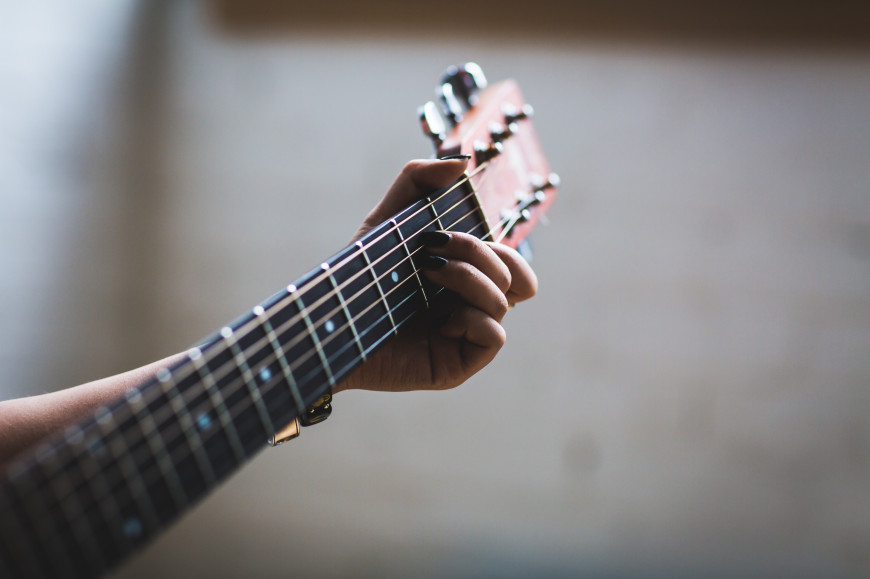Music Learning Styles

Make the Most of the Way You Think About Music
I've been teaching flamenco guitar to a married couple for the past two years. We have all three noticed how differently the two students learn. In fact, they couldn't be more opposite.
Peter came to guitar with an amateur singing background. He could already sing a handful of tunes and had a good ear for harmonic changes before he even picked up a guitar. Peter approaches the structure of a song purely from knowing how it sounds. Tell him to play three measures of Am and then two of Dm, two of E7, and end on Am, and he would lose track counting. Ask him to memorize an introduction written out with a strumming pattern and chord names – impossible. Nevertheless, he always knows where he is in a song and what the guitar should be doing, even when he is struggling technically.
Tina, in contrast, needs everything spelled out clearly before she can begin. Just listening to the song is too overwhelming. But show her the chords, write out how the intro goes with clear measures and strumming patterns, and she'll have it memorized in a week. Hearing the chord changes in a new song challenges her, but her memory for chord progressions and concrete information helps compensate. As long as she keeps count of the measures and listens carefully for the beat, she can play along with a recording.
Do you see yourself in one of these two learning styles? I think of Peter's approach to the guitar as an 'outside to inside' method. First he understands the big picture, then he fills in the details. Tina's approach, which I'll call 'inside to outside,' is to understand the details first. When she is confident in the details, she puts them together to form the big picture.
These descriptions may sound similar to the familiar idea of left-brain and right-brain thinking. However, I'm avoiding using those terms because in my experience, how a person thinks about music doesn't correlate with whether they seem to be a rational or creative type. Creative types can be analytical about music, and logical types can be naturally intuitive musicians. For the record, Peter and Tina are both accountants and both seem pretty stereotypically 'left-brained.'
The ideal is a balance of the outside-in and inside-out approaches. You have to understand the music as a whole, and also be able to break it down into details in order to perfect it and make it work in your own hands. Peter and Tina are rather extreme cases, but they are not alone. If you lean heavily to one approach or the other when you're starting out, here are some tips to balance out your musicianship.
Outside-in Learners
Outside-in learners have a natural aptitude for getting the big picture. They have to feel the music before they can think about it, and are often naturally expressive players. For these students, the challenge is usually discipline. They catch onto the main idea quickly, and the parts of a song that come easily to them sound good on the first day. The parts of the song that involve more effort baffle them. They avoid playing the difficult parts and get frustrated when they know exactly how a piece should go, but can't make their hands do it.
If this sounds like you, you should:
- Take lessons regularly. You need the regular motivation to tackle the challenges. Make sure that your teacher knows that you want to be pushed. Your teacher may also show you some tricks for making potentially boring detail-work more fun and productive.
- Embrace technique. A well-crafted warm-up can address all the fundamentals of playing guitar in a quick routine. When you're in shape technically, the challenges you encounter in repertoire are less daunting and quicker to resolve.
- Start with the hard parts of a piece. Obligate yourself to improve on a difficult passage before you start running through entire songs.
- Make guitar a social activity. Take a group class and practice with others. Explain things to other students when you can. Going over the motions with someone else helps solidify everything for you too, and it's often more fun than solitary practice.
- Accept occasional tedium. Regardless of your natural aptitude at the beginnings, at some point your advancement will depend on careful, mindful repetitions. The sooner you accept this, the faster you'll advance.
Inside-out Learners
Inside-out learners are great at fine-tuning and perfecting music. They generally have an ear for details and inherent patience and discipline. The drawback is that their attention to detail often slows them down, especially early on in their studies. Their early playing may sound mechanical, and over-analysis distracts them from artistic interpretation. While they are often extremely musically capable, it takes them longer to feel confident expressing themselves musically.
If you see yourself in this description, try these tips:
- Take an outside-in approach to new material. The first step should be analyzing the structure. If the piece is melodic, learn to sing the melody. Find the high points and climaxes. Figure out how the piece works musically before you bring your hands into it.
- Play mostly repertoire at or below your level. That way you can master the technical challenges quickly and spend more time on interpretation and expressing yourself.
- Cultivate a healthy relationship with technique. Some inside-out learners spend too much time on exercises because this kind of work appeals to their analytical approach. Warm-up routines are great, but don't give technique more than twenty percent of your practice time. The end goal is playing songs, not scales.
- Get out of your comfort zone. Invent a melody a day. Learn to improvise freely and play whatever comes to mind, without worry over whether it sounds 'good' or not. Play along with favorite recordings without any particular goal.
- Accept that perfection doesn't exist. An ear for detail can be both your best friend and your worst enemy. Sometimes we need to concentrate on making every note in a chord sound at the perfect volume with consistent tone. Other times we have to let go and just play music. Especially when we share our music with others, playing expressively with some buzzed strings and wrong notes is infinitely more rewarding than playing perfectly without heart.
Whatever your natural musical inclinations fall, know that balance is the key. Good musicians need to take a big-picture, outside-in approach at some times, and a detail-oriented inside-out approach at other times. I've had students of both types grow and advance to impressive levels of musicianship. Know yourself and use your strengths to your advantage. Identify and attend to your weaknesses, and everything else will fall into place.
 |
Leah Kruszewski has been a guitar teacher for nearly ten years, specializing in acoustic, classical, flamenco, and fingerstyle guitar. Learn more about her private lessons. |
Find more Guitar Classes and Tutorials





